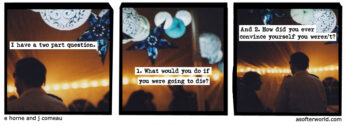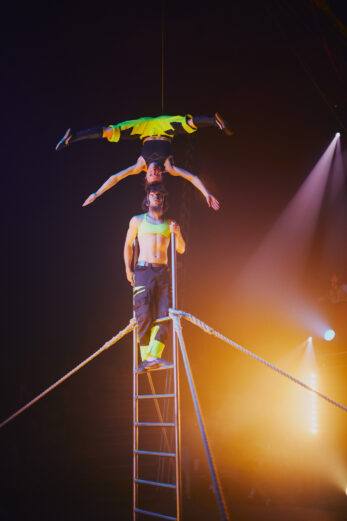
When was the last time you heard circus mentioned? Most probably “circus” was not to bring light to the most amazing acrobats of our time or the history, not to describe the seamless and rapid collaboration of a group of professionals. Probably not even a welcoming event to bring your family to in order to escape the monotonous everyday life of a busy citizen. Mainstream media has adopted the word “circus” to describe (often politicians or sports events creating) a chaos where everyone has lost track of what they were aiming for, and the level of collaboration skills is nonexistent.
Apart from the community of circus enthusiasts, circus is rarely written about nor discussed in written form. Most of the knowledge of its history and skills are either forgotten or passed on in non-documented manner. Outside of the community of circus enthusiasts, we can see something that can be called a high level of illiteracy in circus, a lack of acrobatic literacy, and a series of misinterpretations regarding the aims, processes and results of circus individuals or businesses. I assume this illiteracy is a result of either a lack of interest or a lack of possibility to come to better understand circus.
Circus being defined as a ”high risk” activity is very problematic for the people practicing circus.
So what is it that the circus serves? An audience member probably would expect some type of physical performances displaying a skill element often unnecessary for basic everyday life. Most claim that in a circus we see high risks. This common event of the circus being defined as a “high risk” activity (by most often people very unqualified at risk management within the circus context) is very problematic for the people practicing circus.
In reality, no one comes to the circus to witness actual risk. In a circus we come to witness high skills in risk management.
To perform something that is a real risk to the performer or the audience requires no mastery of skill at all. One could drink a liter of diesel, shortcut the two poles of a car battery with a metal wrench, or go remove all of the bolts holding the seating together before the audience climbs in. Only sociopaths would pay to see such a performance.
Instead, what we can see in a circus is risk management at a very high level. The performer’s bodies and minds are extremely trained to avoid all of the possible hazardous outcomes of the absurd actions they perform, like hanging from one foot in 10 meter height, juggling multiple objects simultaneously or landing on their feet after spinning in the air around their own horizontal axis.
These actions could be risky, if you place someone unqualified to perform them. The basic audience member assumes to watch a risky action, because they project themselves in the shoes of the acrobat. But the acrobat performing the action actually is highly qualified for what they do, and is actually not taking the risk that the audience member would.
The process of becoming a professional at risk management takes years to master. The element of virtuosity that is reached is always a result of a long dedication, which often catches the spectators interest and awe. The elements needed are to adapt the body to be physically capable of executing the action (and preferably manage even harder actions on your best days, to avoid continuously performing on the edge of your capacities), to gain awareness of the consequences of your actions and those around you, and to learn to take and carry responsibility for yourself and others.
Seems like pretty basic things when written down, but in the society we live in capacity, awareness and taking responsibility are not trending at the moment.
Insurance companies are trying to make us believe that by just paying some dollars everything will be under control. Global events, such as the Covid-pandemic make it painfully obvious that nothing is under control. People generally would prefer that the risk management they need to take responsibility for would be very close to 0%, be it economical risk management, physical risk management, or other. Whenever there is an attempt of a system taking over the totality of risk management, like in the case of automated traffic, we have to admit that the task is not so easy to actually implement in real life.
Risk management carried on an individual and community level can lead to big achievements.
Circus people just by existing are having a different claim. Risk management carried on an individual and community level can lead to such big achievements that it becomes hard to believe possible.
Circus skills are trivial and absurd for an acrobatically illiterate witness. It is easy to call someone crazy instead of extremely professional for attempting a quintuple salto, just because we don’t know ourselves how to execute even a single one. It is tempting to declare someone hanging in 15 m without a safety net to be in mortal danger just because we are not aware that they are capable of climbing up and down from there for 20 minutes without feeling tired.
To learn risk management is physically tough, and emotionally even tougher. You feel fear, anxiety, your body will send all the reactions necessary to communicate that it does not want to face this process. In order to prevail, you need to have a certain degree of violence and stubbornness to fight the deep ingrained wish of just giving up, having it easy and rather watching someone face their fears.
In the mastery of the process lies the real discovery — you actually cannot make life 100% safe and predictable. Despite all the meticulous preparations, a sickness can catch you, a natural catastrophe can destroy your house or a lunatic choose your loved ones as their random target. We have no control over happenings beyond our control. Everyone will end up dead, one way or another.
I don’t think that circus performers are pretending to be superhuman. I think they are a step closer to knowing where the limitations of being a human currently lie, accepting them, and trying to make the best of it.
The common illiteracy concerning acrobatics makes the circus artists at best undervalued, and at worst illegal and forbidden from carrying out their job.
To give an example from my own touring life, the acrobatics we perform with my partner on a daily basis are questionable from the point of view of the work legislation of several countries (see picture 1). Working with a ladder is clearly regulated. A ladder cannot be used to access a place repeatedly. If that is the case, the ladder has to be replaced by a stationary structure such as stairs or scaffolding. This is just one example amongst many others that make performing circus skills legally challenging.

As I see it, the circus people bravely choosing to live in the margins of mainstream society with their lifestyle, time-management and mobility to make a living are worth looking up to and learning from instead of being considered outlaws. Watching performers like them can inspire anyone towards empowerment, collaboration, hope and joy.
The process you need to go to to learn high level skills actually translates very well into all kinds of other areas of life: capability, realistic knowledge of your abilities and limitations, trustworthiness, capacity to carry responsibility and being aware of your surroundings and the consequences of your actions. These qualities make individuals who have the power of action to deal with the multifaceted environmental and social challenges we deal with in the world.
Maybe part of the thrill of why the audiences choose to watch the circus is to also get to experience this process, even if they were not committed to it themselves. They feel similar emotions watching the acrobats perform. They feel reassured with their own body sitting in the safety of the seat, yet they get to share with the acrobat and everyone present the relief and rush of adrenaline that can best be found in moments when you surpass your limits. The experience of collective kinesthetic empathy can give one energy for weeks to come.
To end this ode to circus as a force to make the world a better place, I will share two circus actions that inspired me more than any motivational quote ever did:
One was Super Silva in Sirkus Finlandia some years back. He does a solo flying trapeze and ceiling walk act in 12 meters. I did not talk to him personally, but the legend says he has twice fallen from his act (not due to acrobatic failure, but a rigging mistake). He still keeps on performing his act unmodified, as he strongly believes that if god wanted him to stop, god would make him stop.
The second was part of a dance piece called Tomorrow’s Witnesses in Luleå (choreography by Benno Voorham). An around 90 year old lady speaks a monologue of her past as a war child deported from Finland to Sweden. After the very touching personal history, she stands up next to her chair, and with visible difficulty and determination proceeds to kneel down, look at the audience, and pull herself back up again on her feet. All the other young dancers taking part in the piece are gathered around her, clearly ready to jump to her aid if she would not manage to get up on her own. She delivers what she wanted to display, and gets up to her feet unassisted.
Even if this action was carried out by a non-acrobat in a theater venue as a part of a dance performance, for me it clearly was a circus action. She displayed a process of working on pushing her own limits and risk management within her actions. She chose carefully a movement that clearly communicated with the audience in an understandable way through her body. She kept her promise of making her trick happen in the context of the performance. Thinking about this action she chose to show still brings tears to my eyes.
The effect of her kneeling and standing up live in front of me could not be substituted by reading a text about it, showing a video projection, or hiring an actor to do this action instead of her. The same theme repeats in all the best circus performances I have experienced. The full effect can only be experienced live sharing space with the performers. We watch nervously, hoping that the trick will be successful also today. We feel the wave of relief only once we witnessed the successful result of the attempt, and the balance of the performance space is restored. No other art form can create this experience.
Sources:
Ladder as a working space:
https://www.finlex.fi/fi/laki/alkup/2006/20060836
https://www.av.se/globalassets/filer/publikationer/foreskrifter/stegar-och-arbetsbockar-foreskrifter-afs2004-3.pdf
https://www.legifrance.gouv.fr/codes/article_lc/LEGIARTI000018511760
Circus actions:
http://www.circopedia.org/Super_Silva_Video_(2011)
https://vimeo.com/300465867



